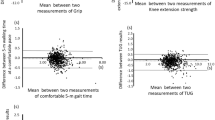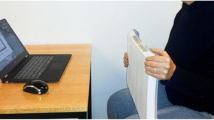Abstract
This study was a continuation of 2 investigations into methods used to help discriminate between maximum and submaximum effort in maximal power grip (strength), and repeated maximal power grip (strength-endurance). The purpose was to identify valid discriminator variables, which in combination would improve the detection of submaximum effort over single discriminator variables. Three discriminator variables were identified for power grip strength, and also for power grip strength-endurance. A criterion test was developed where the criterion for intentional submaximum effort was ≥ two positive discriminator variables, and the criterion for a maximum effort was ≤ one positive discriminator variable in both power grip strength and strength-endurance. The criterion test correctly identified 100% of healthy control workers (n=26) applying maximum effort in power grip strength and strength-endurance; and correctly identified a total of 20 out of 24 (83.3%) submaximum tests for workers purposefully restricting their performances. The criterion test was also applied across the power grip data for a retrospective sample of 51 Workers Compensation patients with unilateral upper extremity injuries, classifying 17 patients (33.3%) as submaximal when using their unaffected limbs. Cominations of multiple discriminator variables were found to improve detection rates for submaximum effort when compared to using single discriminator variables.
Similar content being viewed by others
References
King JW, Berryhill BH. Assessing maximum effort in upper extremity functional testing.Work 1991; 1(3): 65–76.
Niemeyer LO, Matheson LN, Carlton RS. Testing consistency of effort: bte work simulator.Indust Rehab Q 1989; 2(1): 5, 12–13, 27–32.
Hildreth DH, Breidenbach WC, Lister GD, Hodges AD. Detection of submaximal effort by use of the rapid exchange grip.J Hand Surg 1989; 14A: 742–745.
Neiburgh B, Marion R. Detecting sincerity of effort when measuring grip strength.Am J Phys Med 1987; 66: 16–24.
Robinson ME, Geisser ME, Hanson CS, O’Connor PD. Detecting submaximal efforts in grip strength testing with the coefficient of variation.J Occup Rehab 1993; 3: 45–50.
Stokes HM. The seriously injured hand—weakness of grip.J Occup Med 1983; 25: 683–684.
Chengalur SN, Smith GA, Nelson RC, Sadoff AM. Assessing sincerity of effort in maximal grip strength tests. Part II.Am J Phys Med Rehab 1990; 69: 148–163.
Gilbert JC, Knowlton RG. Simple methods to determine sincerity of effort during a maximal isometric test of grip strength.Am J Phys Med 1983; 62: 135–144.
Kroemer KHE, Marras WS. Evaluation of maximal and submaximal static muscle exertions.Hum Factors 1981; 23(6): 643–653.
Kroemer KHE, Marras WS. Toward an objective assessment of the maximal voluntary contraction component in routine muscle strength measurements.Eur J Appl Physiol 1980; 45: 1–9.
Robertson LD, Mullinax CM, Brodowicz GR, Swafford AR. Muscular fatigue patterning in power grip assessment.J Occup Rehab 1996; 6(1): 71–85.
Smith G, Nelson RC, Sadoff SJ, Sadoff AM. Assessing sincerity of effort in maximal grip strength tests.Am J Phys Med Rehab 1989; 68: 73–80.
King JW, Berryhill BH. A comparison of two static grip testing methods and its clinical applications: a preliminary study.J Hand Ther 1988; 6: 204–208.
Robertson LD, Mullinax CM, Brodowicz GR, Miller RA, Swafford AR. The relationship between two power-grip testing devices and their utility in physical capacity evaluations.J Hand Ther 1993; 6: 194–201.
Fess EE, Moran C.Clinical assessment and recommendations. Garner, NC: American Society of Hand Therapists. 1981.
Chaffin D. Ergonomics guide for the assessment of human strength.Am Ind Hyg Assoc J 1975; 36: 505–510.
Vincent WJ.Statistics in kinesiology. Champaign, IL: Human Kinetics, 1994, pp. 80–83, 178–181.
National Institute for Occupational Safety and Health-NIOSH:Work practices guide for manual lifting. Springfield VA: National Institute for Occupational Safety and Health, U.S. Department of Commerce, 1981.
Matheson LN, Carlton R, Niemeyer LO. Grip strength in a disabled sample: Reliability and normative standards.Indust Rehab Q 1988; 1(3): 9, 17–23.
Clarke HH, Shay CT, Mathews DK. Strength decrement index: A new test of muscular fatigue.Arch Phys Med Rehab 1955; 36: 376.
Author information
Authors and Affiliations
Rights and permissions
About this article
Cite this article
Robertson, L.D., Brodowicz, G.R. & Swafford, A.R. Improved detection of submaximum effort in upper extremity strength and strength-endurance performance testing. J Occup Rehab 7, 83–95 (1997). https://doi.org/10.1007/BF02765879
Issue Date:
DOI: https://doi.org/10.1007/BF02765879




